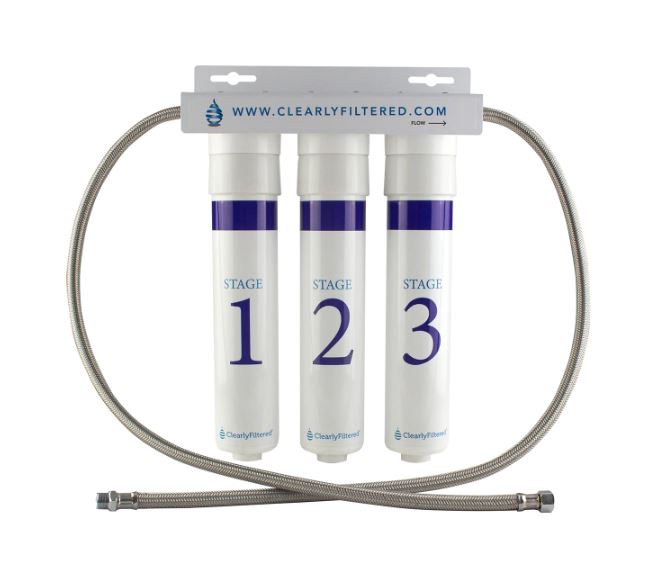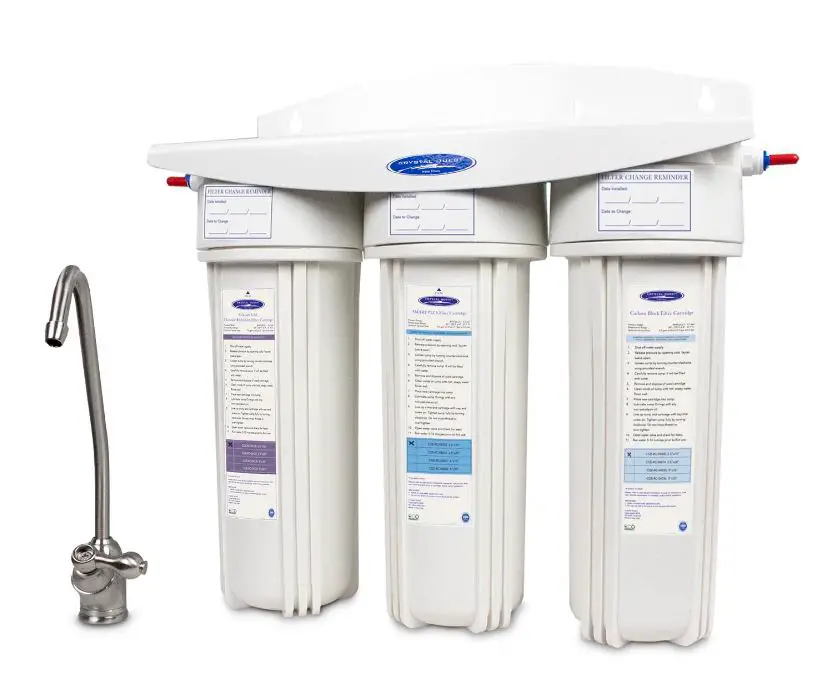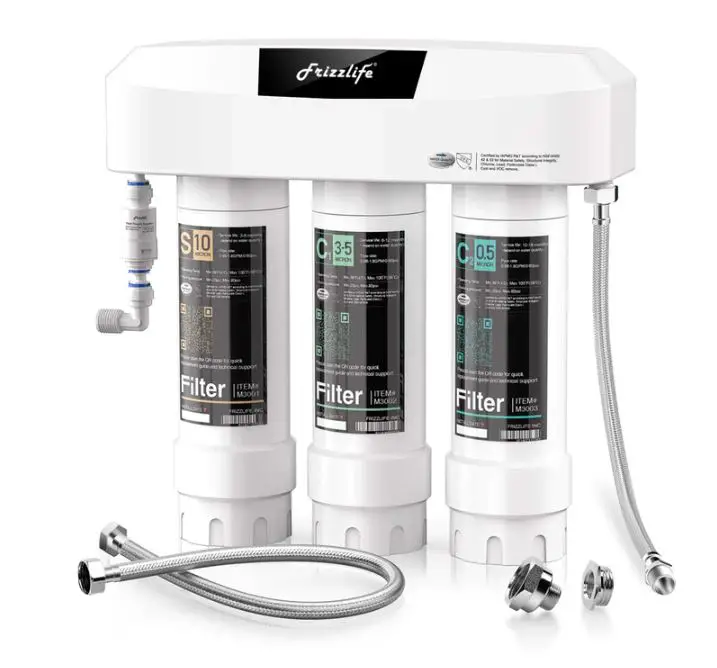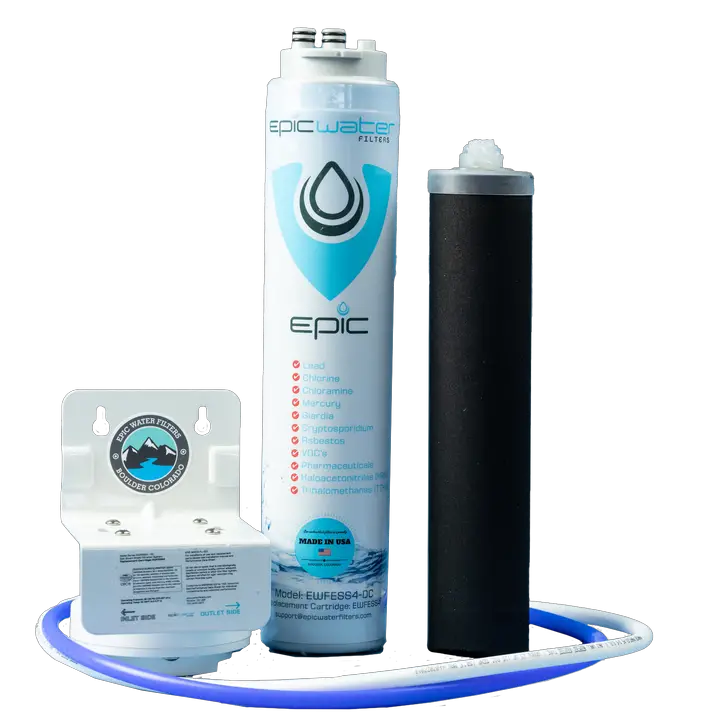Fluoride can help prevent tooth decay, but excessive fluoride consumption has been linked to conditions like cancer and cognitive problems. For these reasons, many want to remove fluoride from their drinking water, and wonder if under sink water filters would be effective, as they are convenient.
Under sink water filters can effectively remove up to 95 percent of fluoride from your water. Under sink filters that use activated alumina or bone char filtration media have the greatest fluoride removal capacity. Whereas under sink activated carbon filters can reduce fluoride in water by ~60%.
This article will take you through what fluoride is, how it gets into water, how people are exposed to it, and explain the negative effects of fluoride. It will also explain how an under sink water filter can remove fluoride and recommend 6 under sink water filters able to remove fluoride.
Do under sink water filters remove fluoride?
Fluoride is a naturally occurring mineral that is released into the water, air, and soil during weathering.
While fluoride is present in every body of water, the concentration of fluoride differs from one location to another. For instance, in Colorado Springs there are areas with incredibly high concentrations of naturally occurring fluoride compared to other parts of the El Paso County.
However, the fluoride in our drinking water, or that found in processed beverages (e.g., soft drinks) come from a public health intervention. These fluorides are typically from salts, such as sodium fluoride or stannous fluoride.
Public water systems add fluoride to our water during treatment processes and accounts for roughly 75% of people’s total fluoride intake.
Fluoride has become well-known in the USA for being added to our drinking supply. Although, your state or local government decides whether to add it to the water supply to reduce tooth decay or not, with many states or counties deciding against fluoridation.
Check out the table below for a complete breakdown of just how much of your state is subject to fluoridation.

How under sink water filters remove fluoride
Many under-sink water filters can effectively remove the fluoride from your drinking water because they use either activated alumina filters, bone char, or in some cases activated carbon filters to remove contaminants.
These filters use the adsorption approach to filter out fluoride by bonding with the fluoride ions, leaving the water with little to no fluoride.
As water comes from your tap (or well) it moves through the connected filters underneath your kitchen sink, allowing them to remove contaminants, including fluoride before making it makes its way to the kitchen faucet.
Activated alumina filters: One of the most efficient methods for removing fluoride from water is activated alumina (AA). Under sink water filters that use activated alumina filters, effectively remove water impurities like fluoride using the adsorption purification process.
They typically use granular and porous alumina media to remove up to 99 percent of the fluoride in water by bonding with the fluoride ions and lowering their concentration in the water.
Bone Char filters: Bone char contains both carbon and hydroxyapatite. The structural functionality of these materials mean filters made from bone char can adsorb fluoride via ion exchange and electrostatic interaction. Bone char can remove more than 99.8 percent of fluoride from water.
Activated carbon filters– Many under sink water filters use activated carbon filters to remove fluoride. Although they are not the greatest choice for removing fluoride from fluoridated water, activated carbon filters can lower some fluoride amounts in pure water, generally between 30 and 60%. However, filters made from granular activated carbon (GAC) are capable of removing more than 95 percent of fluoride ions.
While there are no filters currently available with a combination of bone char and GAC, recent research has shown that a filter composed of both these materials is able to remove an incredible 100% of the fluoride in water.
The top 6 under sink water filters that remove fluoride
Check out these top brands on Amazon or their respective websites if you’re looking to invest in a great under-sink water filter that can remove fluoride from your drinking water.
Water Purification Guide also has a complete breakdown of water filter pitchers that remove fluoride available here.
1. Clearly Filtered Under Sink water filter system

The Clearly Filtered under the sink water filter system is capable of removing 90.7% fluoride as well as more than 232 other contaminants, including heavy metals, pollutants, and chemicals. Their method is designed to target fluoride and lead using patented technology.
It comes with three filters, each of which has a special function. They make it simple to get clean water from any tap when used together.
The advanced priming filter uses a sophisticated coconut carbon filter to remove sediments and particles, while the heavy metal filter removes heavy metals, herbicides, pesticides, lead, chromium, and PFAS.
The third filter is a built-in fluoride filter, which helps to remove up to 90.7% of fluoride, leaving behind valuable minerals. Something typical RO systems cannot do.
This brand makes it at the top of the list because it is made in the USA and removes much more water contaminants apart from fluoride in drinking water.
The brand also uses an intelligent technology, and does not produce excess waste-water the way standard RO systems do, making it the ideal filter if you are looking to remove fluoride from your drinking water.
Pros:
- Easy to install and use.
- Compatible with any sink.
- Made in the USA.
- Portable and space-saving design.
- Little wastewater.
- Long filter life.
- 100% BPA-free.
2. Crystal Quest Fluoride Under Sink Water Filter System

The Crystal Quest under-sink water filtration system is one of the best systems for reducing or removing fluoride, as well as heavy metals and chlorine from your drinking water.
Water passes through a fluoride removal water filter cartridge that also contains a calcium charcoal granulated activated carbon (GAC) filter to remove pollutants from the water, including not only fluoride but also arsenic and lead.
The best thing about this filter is that you can buy it as a single, double or triple system and they all remove fluoride.
This brand is compatible with a leak detector smart valve, which aids in preventing circumstances in the water line that are not known, such as high water pressure, a lack of a pressure regulator, water spiking or pounding, or improper installation.
Pros:
- It is quick and easy to install and use.
- Attractive and convenient.
3. Frizzlife 3-Stage Under Sink Water Filter System

An under-sink water filter called the Frizzlife 3-Stage can efficiently remove over 99 percent of contaminants from tap water, including fluoride, dust, sediments, lead, chlorine, chloramine, heavy metals, and VOCs, while still retaining all the helpful minerals.
Using the activated carbon filter and other filters suitable for contaminant removal based on the micron size, the frizzlife filter removes the necessary contaminants from water.
This brand’s material safety, structural integrity, flow rate, and filtration efficiency have all undergone thorough testing, and it has been certified by IAMPO in accordance with NSF/AISI 42 and 53.
Pros:
- Great tasting water.
- Long-lasting filters.
- Fast water flow rate of @60 psi.
- Easy to install and use.
- Quick filter replacement.
- Cost-effective.
- Sleek and space-saving.
4. Epic Smart shield under sink water filter

The Epic Smart Shield under-sink water filter eliminates 99.99 percent of more than 70 identified pollutants in tap water by using eco-friendly activated coconut carbon block filter material which is also able to get rid of some fluoride.
Other contaminants the filter can remove include chlorine, heavy metals, industrial and agricultural pollutants, and trace medicines.
The large surface area of activated coconut carbon adsorbs impurities including fluoride, cysts, heavy metals, pesticides, medicines, and herbicides as they try to pass by, it uses an adsorption approach to remove water particles.
In contrast to other water filters that remove these minerals, this brand “intelligently” filters impurities out while leaving naturally occurring minerals like calcium, magnesium, and potassium intact.
Pros:
- BPA-free.
- Long filter life.
- Easy to install and use.
- Made in the USA.
- Certified against NSF/ANSI 42, 53, and 401. (Chlorine, lead, pharmaceuticals).
- Great tasting water.
- Efficient and effective.
Related Questions
How people are exposed to fluoride
There are a couple of ways people can are exposed to fluoride, apart from fluoridated water, such as food, and fluoride-made household products.
Fluoride can also be ingested from food. However, food does not naturally contain high fluoride content. Only certain types of processed food that have been prepared with fluoridated water, such as cereals, expose people to an increase in fluoride consumption.
Fluoride is also present in a few dietary supplements, including several multivitamin/multimineral formulations. Sodium fluoride is the most common type of fluoride found in dietary supplements.
Most dental products, including toothpaste, mouthwash, vitamins, gel, and foam, also contain fluoride, exposing us to fluoride each time we use them.
Teflon (non-stick) cookware, which frequently includes fluoride, such as dishes and pans, may also expose you to fluoride.
In fact, many pesticides include fluoride, purchasing organic vegetables that has been pesticide-treated and can also potentially expose you to fluoride. But the main way we are exposed to fluoride is through fluoridated drinking water.
What are the negative effects of fluoride?
Fluoride generally has no negative effects on human health, but excessive doses (like anything in excess) can be harmful. Fluoride can be helpful in tiny amounts, particularly when it comes to avoiding tooth decay and supporting children’s strong bones.
In fact, according to research, children should consume between 0.01 and 0.7 milligrams of fluoride per day, while adults should consume between 2 and 4 milligrams.
However, ingesting higher levels of fluoride than the recommended amounts (i.e 5 milligrams and above) can lead to:
- Dental fluorosis which can result in stains, small dents, or white lines or spots.
- Cognitive impairment
- Skeletal fluorosis
- Cancer.
Brain and nerve cells may also experience problems as a result of excessive fluoridation of the water.
Exposure to fluoride by swallowing dental products, such as toothpaste and mouthwash, can also lead to issues such as:
- Abdominal pain.
- Nausea.
- Bone pain.
- Vomiting
- Diarrhea
- Death (in rare cases).
Do APEC water filters remove fluoride?
APEC reverse osmosis water filters can remove between 80% and 90% of the fluoride in your drinking water. These systems use several filters, which help to remove fluoride successively, and include a reverse osmosis membranes and activated alumina filter.
The artificial aluminum oxide known as activated alumina eliminates fluoride effectively. Combined with a Reverse Osmosis membrane filtration device to remove up to 95% of the fluoride.
Other filters that APEC systems have include sediment and carbon filters, but these filters are ineffective in removing fluoride.
Is chlorine and fluoride the same?
Although they are both compounds that are frequently found in soil and rocks, fluorine and chlorine are not the same. While fluorine is a chemical element that occurs naturally and is released into water and soil, chlorine is a toxic, green, gaseous chemical element that is used to clean water.

